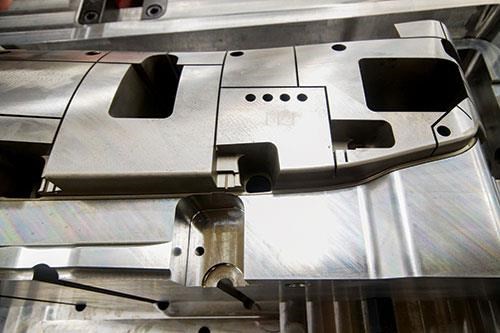Busting Another Myth of Conformal Cooling
Several years ago, I traveled around the midwest giving talks on the merits of aluminum molds. Aluminum has much to offer over steel, yet I’m willing to bet that there have been few aluminum conformal molds made. I just came across an investigative study and it confirms what I have said about aluminum molds in the past.

Several years ago, I traveled around the midwest with Rich Oles (PSG) giving talks on the merits of aluminum molds. Aluminum has much to offer over steel. Yet I’m willing to bet that there have been few aluminum conformal molds made. I just came across an investigative study done collaboratively with the Aluminum Injection Mold Co., Dave Klafhen (Plastic Processing Consultant), and Alcoa Forged & Cast Products. (www.alcoa.com/mold/en/pdf/spiral_report.pdf) It confirms what I have said about aluminum molds in the past.
Why is this important? The design of conformal molds is a game changer. The cooling channels can be closer to the mold wall. However, if the conformal mold is made from aluminum, the temperature of the mold surface will be even more uniform than a conformal mold made from steel. The thermal conductivity of aluminum is so much higher than steel and diffuses heat so much faster. This produces 20 to 40 percent faster cycles, fewer rejects and tighter tolerances. The 40 percent cycle savings is due to a 20 percent savings using aluminum, plus 20 percent savings because it is a conformal mold.
For more on the myths of conformal cooling, check out an upcoming new FastTrack training program on September 4th and 5th, near Toledo, OH, sponsored by Plastic Technologies, Inc. (PTI), which will feature two modules— Conformal Cooling for Injection Molding (September 4th) and Medical Plastics Design and Processing (September 5th).
Conformal Cooling Seminar Outline
1.) Understanding heat management
2.) How resin selection affects heat management.
How resins can be modified to cycle faster.
3.) Choosing the right mold metal.
4.) Understanding how Fluid Dynamics impacts Dynamic Heat Transfer.
5.) Alternative cooling technologies to be used with conformal cooling.
6.) Conforming Cooling Technologies, including a European technology
presentation not seen in North America.
7.) Examples why Moldflow and Computational Fluid Dynamics (CFD) are important,
if not necessary, tools for designing conformal cooling channels
Robert Beard
www.Plastic-Solvers.com
Image courtesy of Alcoa, Inc.
Related Content
-
Corrosion-Resistant, Highly Machinable Tool Steel
Opticut mold steels from Swiss Steel Group member Deutsche Edelstahlwerke apply a novel treatment to the material to eliminate the deterioration caused by the addition of sulfur.
-
Pre-Hardened Mold Steel Material Increases Through-Hardened Ability
Finkl Steel’s patented pre-hardened mold steel grade MD Xtra material achieves high impact strength, enhanced thermal conductivity and is an exceptional solution for deep impression applications.
-
How to Lower Cycle Times With the Right Tool Steel
Combining excellent mechanical properties, high wear resistance and high thermal conductivity in a specialty tool steel yields cycle time reduction.















.jpg;maxWidth=300;quality=90)
